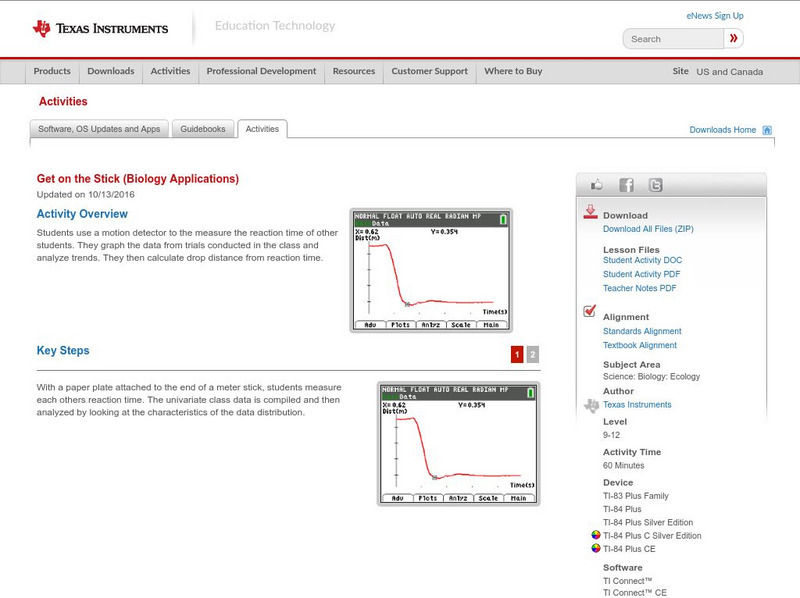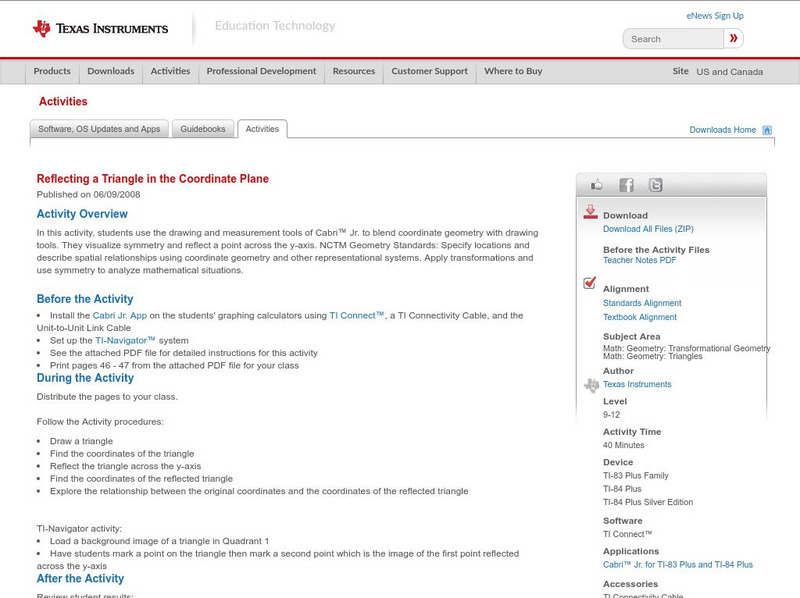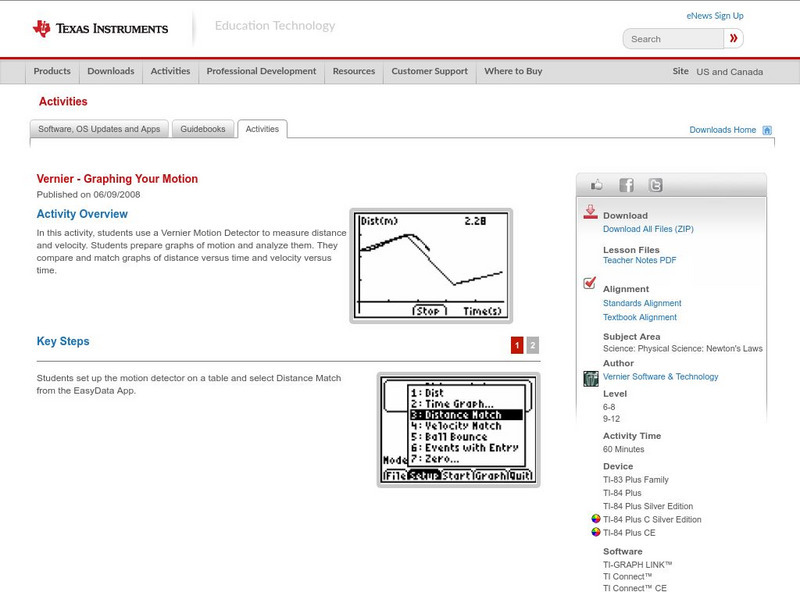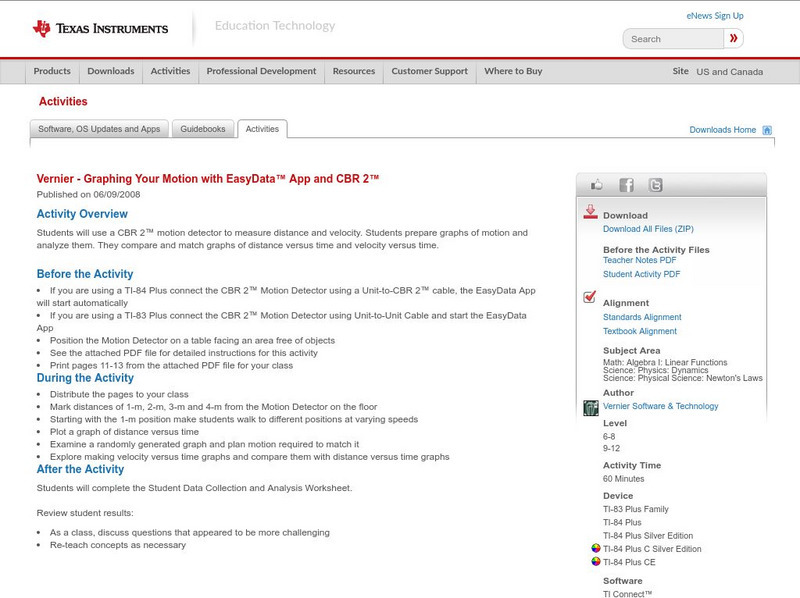Texas Instruments
Texas Instruments: Frictional Forces
In this activity, students' will use a Dual range force sensor to measure the force required to pull a block across different surfaces. They will examine the results to see when more force is needed to move the block and understand the...
Texas Instruments
Texas Instruments: Voltage From Dry Cells
In this activity, students will use a Voltage sensor to measure the voltage produced by new dry cells of each size. They will also determine whether there is a relationship between dry cell size and voltage.
Texas Instruments
Texas Instruments: The Magnetic Field in a Slinky
Students use a Magnetic Field Sensor to measure the magnetic field and the current in a solenoid. They explore factors that affect the magnetic field, study how the field varies in parts of the solenoid, and determine the permeability...
Texas Instruments
Texas Instruments: Is There a Relationship Between Your Fist and Shoe Size?
Students will measure the circumference of their fist and list their shoe size. The lists will be loaded using TI-Navigator in the activity center.
Texas Instruments
Texas Instruments: Is a Square a Special Case of Rectangle?
The definition of square can determine whether it is a special case of a rectangle. Using the Cabri Jr. application, students can get a feel for why its definition makes sense. Along the way, they get experience with perpendiculars,...
Texas Instruments
Texas Instruments: Voltage From Dry Cells
In this activity, students can use a voltage sensor to measure the voltage produced by new dry cells of each size. They will also determine whether there is a relationship between dry cell size and voltage.
Texas Instruments
Texas Instruments: Heart Rate and Body Position
In this activity, students can use a Heart Rate Monitor to measure their heart rate while sitting, lying down, and standing. They will analyze the data collected to determine the effect of body position on heart rate.
Texas Instruments
Texas Instruments: Get on the Stick
In this activity, students' use a motion detector to the measure the reaction time of students. They graph the data from trials conducted in the class and analyze trends. They then calculate drop distance from reaction time.
Texas Instruments
Texas Instruments: Who Says a Watched Pot Never Boils?
In this activity, students' will investigate what causes phase changes in matter.They use a temperature sensor to measure the temperature of a substance and identify visual clues to the phase changes.
Texas Instruments
Texas Instruments: Friction
Students study how the nature of two materials in contact, and the smoothness of their surfaces affect the magnitude of the sliding force of friction. They use a force sensor to measure frictional force for different surfaces.
Texas Instruments
Texas Instruments: Is an Equilateral Triangle a Special Case of Isosceles?
The definition of isosceles triangle can determine whether an equilateral triangle is a special case of an isosceles triangle. Using the Cabri Jr. application, students can get a feel for which definition makes the most sense. Along the...
Texas Instruments
Texas Instruments: Reflecting a Triangle in the Coordinate Plane
In this activity, students use the drawing and measurement tools of Cabri Jr. to blend coordinate geometry with drawing tools. They visualize symmetry and reflect a point across the y-axis.
Texas Instruments
Texas Instruments: Drawing a Line Tangent to a Circle
Students use the drawing and measurement tools of Cabri Jr. to draw a line tangent to a circle. [Requires Adobe Reader.]
Texas Instruments
Texas Instruments: Describing Bivariate Data (Two Quantitative Variables)
Students explore the relationship between two quantitative variables in bivariate data using various x-y plots. They compare the relationships for several categories on the same plot. Students calculate the correlation coefficient to...
Texas Instruments
Texas Instruments: Dynamic Geometry: Basic Constructions
Students use the Cabri Jr. application to draw triangles and construct perpendicular bisectors on the sides of a triangles. They study the properties of a triangle and understand how the measures of angles of a triangle is always 180...
Texas Instruments
Texas Instruments: Math Today When a Ruler Isn't Enough
This activity illustrates a real-life problem that uses trigonometry to solve for an unknown. students can use trigonometric ratios and inverse trigonometric relationships to determine the side of a triangle and the measure of the...
Texas Instruments
Texas Instruments: What Goes Up: Position and Time for a Cart on a Ramp
In this activity, students' will use a motion detector to measure how the position of a cart on a ramp changes with time. They will then determine a parabolic model for the position data using the intercepts.
Texas Instruments
Texas Instruments: Get on the Stick
In this activity, students use a CBR 2 to measure the reaction time of catching a stick. They also learn how to interpret a box plot, and make a five number summary of a single variable data set.
Texas Instruments
Texas Instruments: Graphing Your Motion
In this activity, students use a Motion Detector to measure distance and velocity. Students prepare graphs of motion and analyze them. They compare and match graphs of distance versus time and velocity versus time.
Texas Instruments
Texas Instruments: Keep It Bottled Up: Linear Rates of Pressure Increase
In this activity, students' examine how temperature affects the rate of gas production during a chemical reaction. They measure this rate by recording the pressure variation using a pressure sensor and model the pressure data using a...
Texas Instruments
Texas Instruments: Graphing Your Motion With Easy Data App and Cbr 2
Students can use a CBR 2 motion detector to measure distance and velocity. Students prepare graphs of motion and analyze them. They compare and match graphs of distance versus time and velocity versus time.
Texas Instruments
Texas Instruments: Parallel Lines, Transversals and Angles
This activity allows students to: 1. Identify the pairs of angles formed when a transversal intersects two lines.: 2. Measure angles Using Cabri Jr. 3. Identify relationships between pairs of angles when a transversal intersects parallel...
Texas Instruments
Texas Instruments: Photosynthesis and Respiration
Students use the gas sensors to measure the amounts of oxygen and carbon dioxide consumed or produced by a plant during respiration and photosynthesis. They also determine the rate of respiration and photosynthesis in a plant.
Texas Instruments
Texas Instruments: P H
Students use a pH sensor to measure the pH level of water in a stream or lake. They examine how air pollutants like sulphur dioxide, nitrogen oxides, and carbon dioxide cause acid rain, which affects the pH of water bodies and aquatic...























